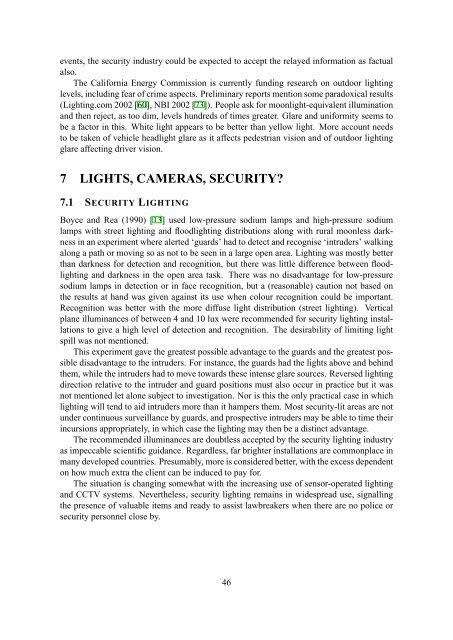outdoor lighting and crime, part 1 - Astronomical Society of Victoria
outdoor lighting and crime, part 1 - Astronomical Society of Victoria
outdoor lighting and crime, part 1 - Astronomical Society of Victoria
Create successful ePaper yourself
Turn your PDF publications into a flip-book with our unique Google optimized e-Paper software.
events, the security industry could be expected to accept the relayed information as factual<br />
also.<br />
The California Energy Commission is currently funding research on <strong>outdoor</strong> <strong>lighting</strong><br />
levels, including fear <strong>of</strong> <strong>crime</strong> aspects. Preliminary reports mention some paradoxical results<br />
(Lighting.com 2002 [60], NBI 2002 [73]). People ask for moonlight-equivalent illumination<br />
<strong>and</strong> then reject, as too dim, levels hundreds <strong>of</strong> times greater. Glare <strong>and</strong> uniformity seems to<br />
be a factor in this. White light appears to be better than yellow light. More account needs<br />
to be taken <strong>of</strong> vehicle headlight glare as it affects pedestrian vision <strong>and</strong> <strong>of</strong> <strong>outdoor</strong> <strong>lighting</strong><br />
glare affecting driver vision.<br />
7 LIGHTS, CAMERAS, SECURITY?<br />
7.1 SECURITY LIGHTING<br />
Boyce <strong>and</strong> Rea (1990) [13] used low-pressure sodium lamps <strong>and</strong> high-pressure sodium<br />
lamps with street <strong>lighting</strong> <strong>and</strong> flood<strong>lighting</strong> distributions along with rural moonless darkness<br />
in an experiment where alerted ‘guards’ had to detect <strong>and</strong> recognise ‘intruders’ walking<br />
along a path or moving so as not to be seen in a large open area. Lighting was mostly better<br />
than darkness for detection <strong>and</strong> recognition, but there was little difference between flood<strong>lighting</strong><br />
<strong>and</strong> darkness in the open area task. There was no disadvantage for low-pressure<br />
sodium lamps in detection or in face recognition, but a (reasonable) caution not based on<br />
the results at h<strong>and</strong> was given against its use when colour recognition could be important.<br />
Recognition was better with the more diffuse light distribution (street <strong>lighting</strong>). Vertical<br />
plane illuminances <strong>of</strong> between 4 <strong>and</strong> 10 lux were recommended for security <strong>lighting</strong> installations<br />
to give a high level <strong>of</strong> detection <strong>and</strong> recognition. The desirability <strong>of</strong> limiting light<br />
spill was not mentioned.<br />
This experiment gave the greatest possible advantage to the guards <strong>and</strong> the greatest possible<br />
disadvantage to the intruders. For instance, the guards had the lights above <strong>and</strong> behind<br />
them, while the intruders had to move towards these intense glare sources. Reversed <strong>lighting</strong><br />
direction relative to the intruder <strong>and</strong> guard positions must also occur in practice but it was<br />
not mentioned let alone subject to investigation. Nor is this the only practical case in which<br />
<strong>lighting</strong> will tend to aid intruders more than it hampers them. Most security-lit areas are not<br />
under continuous surveillance by guards, <strong>and</strong> prospective intruders may be able to time their<br />
incursions appropriately, in which case the <strong>lighting</strong> may then be a distinct advantage.<br />
The recommended illuminances are doubtless accepted by the security <strong>lighting</strong> industry<br />
as impeccable scientific guidance. Regardless, far brighter installations are commonplace in<br />
many developed countries. Presumably, more is considered better, with the excess dependent<br />
on how much extra the client can be induced to pay for.<br />
The situation is changing somewhat with the increasing use <strong>of</strong> sensor-operated <strong>lighting</strong><br />
<strong>and</strong> CCTV systems. Nevertheless, security <strong>lighting</strong> remains in widespread use, signalling<br />
the presence <strong>of</strong> valuable items <strong>and</strong> ready to assist lawbreakers when there are no police or<br />
security personnel close by.<br />
46
















